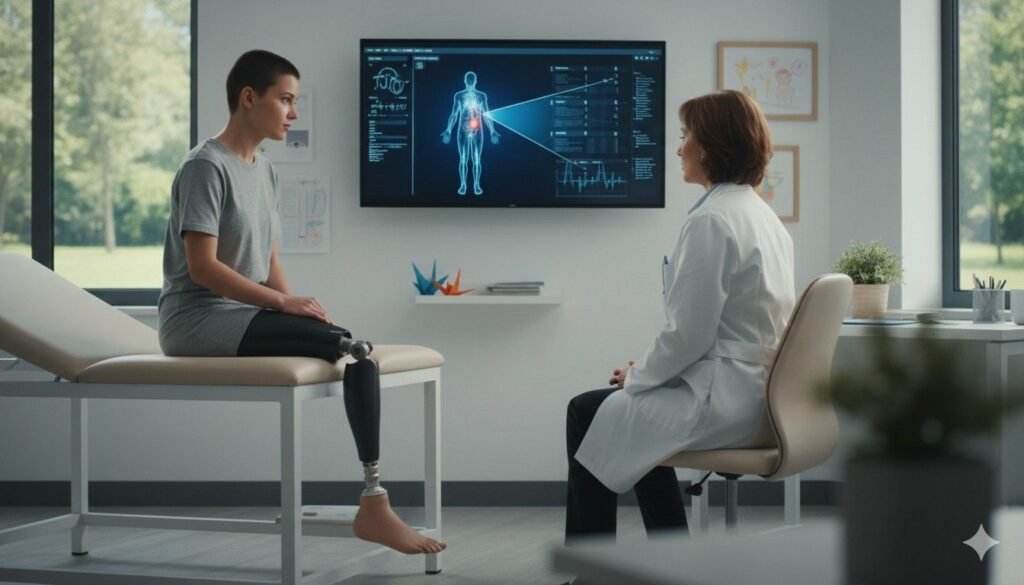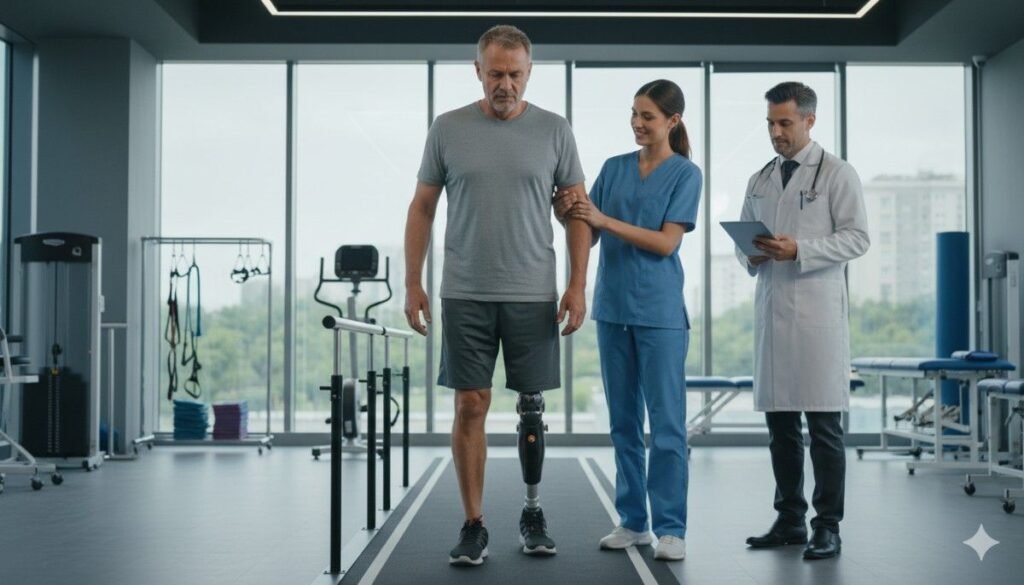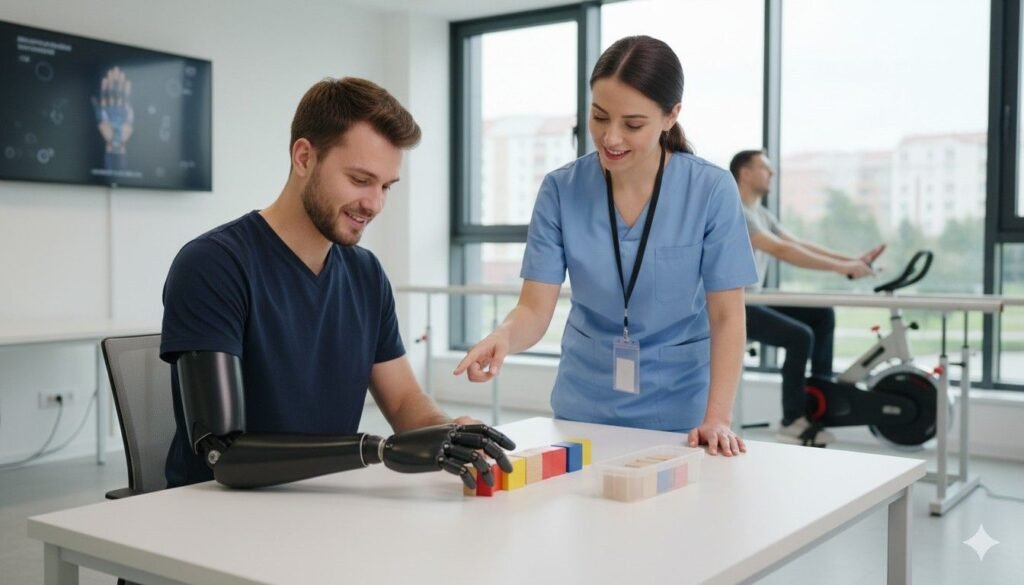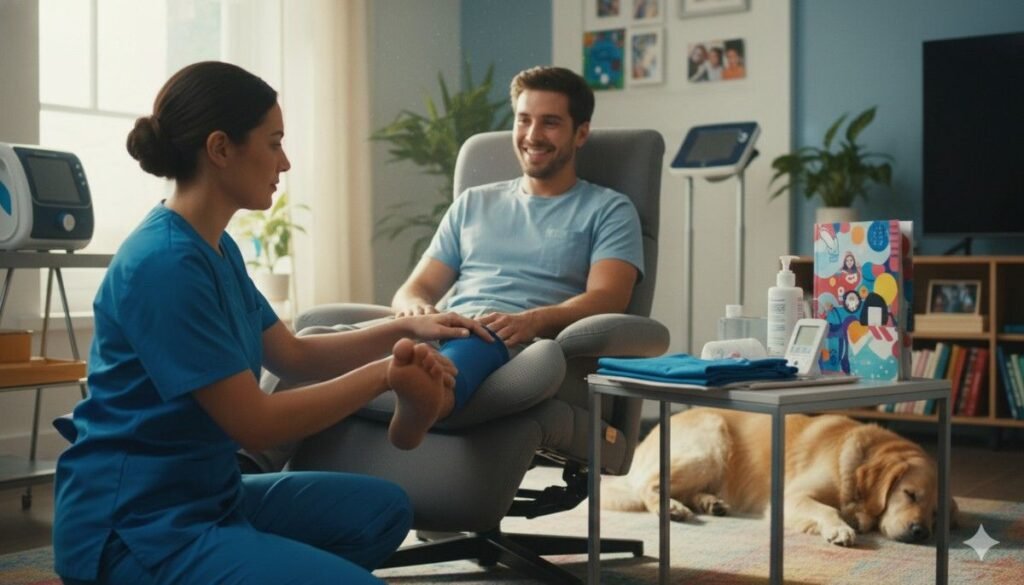Oncology-related amputations create a unique recovery path that looks very different from trauma or vascular cases.
These patients are healing from cancer, coping with treatment side effects, and adjusting to life with a prosthesis all at the same time.
Their bodies are fragile, their energy levels change quickly, and their emotional world is often stretched thin.
For doctors, understanding mobility outcomes, pain control indicators, and quality-of-life benchmarks is essential for guiding safe and hopeful recovery.
These measures help clinicians balance protection with progress and ensure that every step the patient takes supports long-term health and independence.
Why Oncology Amputation Requires a Specialized Clinical Approach
How Cancer Treatment Shapes Recovery
Cancer treatments such as chemotherapy, radiation, and targeted therapies weaken the entire body.
They reduce strength, slow healing, and affect energy in ways that differ from other amputation causes.
Even when the surgical site looks healed, the deeper tissues may still be fragile and slow to respond to pressure or activity.
Doctors must remember that these patients are recovering from two major challenges at once—cancer and amputation—and that both shape their mobility journey.
Why Emotional and Physical Fatigue Limit Early Progress
Oncology patients often carry exhaustion that is not simply physical.
Their bodies feel drained, and their minds feel overwhelmed.
Even small tasks may feel heavy, which affects how quickly they adapt to a prosthesis.
This makes pacing essential.
Doctors must set expectations that honour the patient’s strength levels and avoid pushing too aggressively.
Why Pain Patterns Differ in Oncology Cases
Pain from cancer, surgery, nerve irritation, and treatment side effects often overlap.
This creates complex pain experiences that are hard to categorize.
Some patients feel intense phantom pain, while others struggle with deep bone or soft tissue pain linked to radiation changes.
Doctors need flexible pain-management strategies that adjust as the patient’s medical condition evolves.
Understanding Healing Timelines After Oncology Amputation
Why Healing Is Less Predictable

Cancer affects the immune system, circulatory health, and skin resilience.
This makes healing timelines harder to predict compared to trauma cases.
A wound that seems stable may suddenly become irritated after chemotherapy.
Doctors must review healing signs regularly and avoid assuming linear progress.
How Previous Radiation Therapy Affects Recovery
Radiated tissue becomes stiff, dry, and less elastic.
It is more likely to break down under pressure and takes longer to recover from small irritations.
This makes socket design and alignment even more important in oncology cases.
Radiated limbs often require softer liners and more frequent monitoring.
Why Nutritional Status Matters
Cancer treatments often lead to weight loss, appetite changes, and low protein levels.
These factors slow tissue repair and affect muscle strength.
Doctors who monitor nutrition closely help their patients heal faster and walk more safely.
Small nutritional improvements can dramatically affect early mobility outcomes.
Mobility Outcomes in Oncology Amputation Patients
Why Mobility Starts With Stability
Most oncology patients begin walking with fear, not confidence.
Their bodies feel lighter, weaker, and less predictable than before.
They may worry about falling or damaging the surgical site.
Doctors focus on creating stable, predictable movement patterns early so the patient builds trust in their prosthesis.
Why Early Steps Look Different Than Expected
Weakness from cancer treatment affects the hips, core, and sound limb as much as the residual limb.
This leads to slow steps, uneven gait, and low endurance in the early phase.
These patterns are normal and gradually improve with practice and supportive training.
Doctors help patients see slow mobility not as failure, but as part of the normal oncology recovery process.
Why Endurance Remains Limited for Months
Fatigue is a major barrier in oncology recovery.
Even patients who want to walk more may not have the energy to do so.
Short walking sessions with long rest periods often work best.
Doctors track endurance not by distance alone, but by comfort, confidence, and how long recovery takes after activity.
Tracking Mobility in a Meaningful Way
Using Step Counts to Build Safe Routines
Daily steps help doctors understand the patient’s real activity level.
Some patients avoid walking out of fear or exhaustion.
Others walk too much on good days and then crash afterward.
Step patterns reveal how well patients are managing their energy and whether mobility plans need adjusting.
Watching for Movement Hesitation
Hesitation before standing, turning, or stepping down indicates fear or instability.
This hesitation is often more important than speed or distance when evaluating progress.
It tells doctors where patients feel unsure and where targeted training is needed.
These small cues help shape safer long-term mobility plans.
Tracking How Long Recovery Takes After Activity
Some oncology patients feel fine during walking but struggle afterward.
If fatigue lasts several hours, the session was too intense.
Recovery time becomes a reliable indicator of tolerance.
Doctors use this data to pace mobility progression safely.
Understanding Pain in Oncology Amputation Cases
Why Pain Has Multiple Sources
Cancer surgery disrupts nerves, bones, and soft tissue.
Treatments add neuropathy, bone pain, and tissue irritation.
This makes pain feel widespread and hard to pinpoint.
Doctors must treat pain with a multi-layered approach rather than relying on a single method.
Why Phantom Pain Is More Intense
Oncology patients often experience stronger phantom pain due to nerve trauma and treatment-related changes.
Phantom pain may flare after chemotherapy sessions or periods of stress.
Doctors must monitor patterns carefully and adjust treatment as needed.
This helps prevent fear and frustration from slowing mobility progress.
Why Socket Discomfort Feels Exaggerated
Weakened tissue and reduced sensation make small pressure points feel more irritating.
Even a slight alignment issue can cause significant discomfort.
Doctors adjust sockets frequently in the early weeks to protect fragile tissue.
Frequent refinement keeps patients safe and engaged in mobility training.
Pain Control Strategies That Support Mobility
Combining Medication and Movement

Medication alone rarely solves cancer-related pain.
Gentle movement improves circulation, reduces stiffness, and calms nerve irritation.
Doctors create routines that combine light walking with appropriate medication.
This balanced approach improves comfort without overwhelming the patient.
Using Temperature Therapy for Radiated Tissue
Warm compresses help soften stiff skin caused by radiation.
Cold therapy helps reduce swelling after walking.
Using temperature safely supports healing and reduces discomfort.
Doctors teach patients when and how to use these techniques at home.
Encouraging Relaxation Techniques
Stress worsens both cancer pain and phantom pain.
Breathing exercises, relaxation imagery, and simple mindfulness improve tolerance to daily activity.
These techniques are especially helpful for oncology patients who feel overwhelmed.
Emotional calmness supports better physical performance.
Quality-of-Life Benchmarks After Oncology Amputation
Why QoL Must Be Measured Early and Often
Oncology patients experience rapid changes in mood, energy, independence, and social engagement.
Tracking quality of life helps doctors identify when the patient needs support beyond physical mobility.
QoL declines often signal emotional strain or fear of recurrence.
Monitoring these shifts helps clinicians step in early with meaningful guidance.
How Patients Define Quality of Life
For many patients, QoL means returning to small routines—bathing independently, sitting outdoors, meeting friends, or helping at home.
Doctors ask patients what matters most to them so goals feel personal and uplifting.
This approach builds motivation and hope.
QoL benchmarks must reflect the patient’s values, not just clinical targets.
Why Emotional Health and Pain Must Be Tracked Together
Pain affects mood, and mood affects how the patient perceives pain.
When emotional well-being rises, pain becomes easier to manage.
Tracking both helps doctors create holistic care plans that honour the patient’s full experience.
Better emotional health improves participation and reduces dropout.
How Doctors Can Use Mobility, Pain, and QoL Data Together
Seeing Patterns Across All Three Areas
A patient may walk well but report poor QoL due to fatigue.
Another may have low pain scores but still feel anxious about falling.
Looking at mobility, pain, and QoL together helps doctors identify the root cause of slow progress.
This integrated approach leads to smarter decisions.
Adjusting Goals Based on Combined Outcomes
If pain rises when mobility increases, goals may need to slow down.
If QoL rises even with small mobility gains, goals may be working well.
Doctors adjust plans weekly based on what the data shows.
This ensures that progress remains safe, comfortable, and meaningful.
Using Data to Prepare Patients for Life Beyond Treatment
Outcome trends help doctors prepare patients for long-term independence.
Patients learn what pace works for them, what pain signals to watch for, and how to manage energy wisely.
These lessons shape their life long after cancer treatment ends.
Strong recovery comes from understanding patterns—not rushing milestones.
How Cancer History Influences Prosthetic Design
How Tumor Location Shapes Component Choice

When a tumor affects the bone or soft tissue near the amputation site, the structure of the residual limb changes.
Some patients retain strong muscle groups, while others lose key stabilizing tissue.
Doctors must choose prosthetic components that match the limb’s new mechanical capacity.
This may mean choosing a foot with greater stability, a knee with more controlled motion, or a socket style that spreads pressure gently.
Designing based on anatomy—not generic standards—keeps movement safe and comfortable.
How Radiation Changes Socket and Liner Needs
Radiated skin reacts differently to pressure and friction.
It becomes thinner, more sensitive, and sometimes rigid, making certain liner materials unsuitable.
Soft, cushioned, temperature-neutral liners often work better for oncology patients.
Socket edges must be smoother, and load-bearing areas must be carefully shaped.
Doctors and prosthetists collaborate closely to ensure the socket respects the limits of radiated tissue.
How Chemotherapy Affects Weight and Fit
Chemotherapy often leads to weight shifts—a drop during treatment, then a gradual regain afterward.
These changes alter socket fit dramatically.
A well-fitting socket in week four may feel loose or tight in week ten.
Monitoring fit regularly helps doctors schedule timely adjustments and prevent pressure problems.
Understanding Endurance Patterns in Cancer Survivors
Why Energy Levels Can Change Daily
Oncology patients often describe energy as unpredictable.
Some days they wake up feeling ready to walk; other days, fatigue arrives without warning.
This variability reflects the impact of treatment on the immune system, blood counts, and metabolic balance.
Doctors plan mobility goals with flexible buffers so patients never feel punished by low-energy days.
Why Short Sessions Work Better Than Marathon Training
Extended sessions exhaust oncology patients quickly and cause joint soreness, swelling, and emotional strain.
Short bursts of activity allow them to build stamina safely.
Frequent rests help the body catch up with the demands of movement.
Endurance improves gradually when the pace is gentle, structured, and patient-led.
How Endurance Relates to Pain and QoL
When endurance rises, pain often decreases because muscles support the prosthesis more effectively.
At the same time, quality of life improves because the patient can engage with the world more freely.
These three outcomes—endurance, pain, and QoL—are deeply connected.
Tracking them as a group helps doctors see the whole picture.
How Doctors Can Support Safe, Gradual Progress for Oncology Patients
Creating Predictable Routines
Oncology patients thrive with structure.
A simple schedule—like walking at the same time each morning and evening—helps their bodies adapt to the prosthesis without overwhelm.
Predictability lowers fear and builds trust in movement.
Doctors guide patients to form routines that feel doable and comforting.
Teaching Safe Transitions
Standing up, sitting down, turning around—these movements challenge weak muscles more than walking does.
Cancer patients often feel unstable during transitions.
Teaching controlled movement during these moments prevents falls and boosts confidence.
Good transition skills form the foundation for successful walking.
Encouraging Consistent Micro-Goals
Micro-goals are small actions that feel achievable even on difficult days.
Examples include walking across one room, standing for one extra minute, or taking three steady steps with support.
These small wins accumulate into meaningful progression.
Doctors use micro-goals to maintain momentum when energy is low.
How Oncology Symptoms Influence Walking Mechanics
How Neuropathy Changes Step Patterns
Chemotherapy often causes nerve damage in both the residual limb and the sound limb.
This makes the ground feel unreliable and reduces balance.
Patients shorten their steps to compensate, creating a slow, cautious gait.
Doctors encourage controlled pacing and balance training to reduce fear-driven walking patterns.
How Joint Pain Alters Posture
Cancer medications and reduced activity can worsen joint stiffness.
Pain in the hips, knees, and lower back influences how patients stand and walk.
This leads to posture shifts that affect alignment and wear patterns.
Regular posture checks allow doctors to correct problems before they limit mobility.
How Breathlessness Affects Movement Flow
Some oncology patients experience shortness of breath on exertion.
They may pause frequently or walk with tense shoulders.
Breathlessness disrupts natural gait rhythm and causes fatigue.
Doctors integrate breathing techniques into mobility training to help patients move more smoothly.
Using Pain Patterns to Guide Adjustments and Interventions
Why Pain Mapping Helps Clarify Root Causes

Cancer-related pain can feel diffuse and unpredictable.
Mapping pain during walking, standing, and resting helps identify whether discomfort comes from the socket, alignment, scar tissue, or neuropathy.
These insights guide targeted adjustments.
Pain maps also show whether interventions are working.
How Pain Timing Reveals Troubleshooting Clues
Pain during walking suggests mechanical issues.
Pain after walking suggests tissue irritation or pressure buildup.
Pain at night may be phantom or neuropathic.
Understanding the timing helps doctors choose the correct treatment strategy.
How Emotional Pain and Physical Pain Interact
Fear, grief, and stress intensify physical discomfort.
Cancer survivors often carry emotional burdens that make their pain feel heavier.
Doctors who address emotional health see better overall pain control.
Acknowledging feelings becomes part of the healing process.
How Quality-of-Life Measures Predict Long-Term Recovery
Why Social Participation Matters
Oncology patients often withdraw socially because of fatigue or physical limitations.
But social connection improves mood, motivation, and resilience.
Tracking how often the patient meets others, communicates, or participates in family activities provides a clear QoL indicator.
Social activity is often the first thing to decline—and the first thing to rebuild.
Why Independence Benchmarks Are Crucial
Small acts—like dressing independently, preparing simple meals, or managing personal care—reflect true functional recovery.
These benchmarks also signal whether the patient trusts their prosthesis.
When independence grows, emotional well-being grows too.
Doctors use independence milestones to guide care plans.
Why Sleep Quality Reflects True Healing
Pain, anxiety, and treatment effects often disrupt sleep.
Poor sleep delays healing and reduces mobility potential.
Tracking sleep helps doctors identify pain flares, emotional strain, or overstimulation from therapy.
Improving sleep often improves the entire recovery arc.
How Doctors Can Communicate Effectively With Oncology Patients
Using Gentle, Clear Explanations
Oncology patients absorb information better when it is simple and compassionate.
Medical terminology may feel overwhelming during active cancer recovery.
Clear explanations reduce fear and build trust.
Doctors must explain pacing, risks, and progress in language that feels human and grounding.
Validating Emotional Experiences
Cancer-related amputation carries emotional layers—loss, fear, uncertainty, hope, and exhaustion.
When doctors validate these feelings, patients feel less alone.
This validation encourages honesty about symptoms and challenges.
A supportive conversation can be as healing as a clinical intervention.
Setting Expectations With Hope and Honesty
A realistic yet hopeful outlook keeps patients motivated.
Doctors help patients understand that progress may be slow but meaningful.
Honesty prevents disappointment while hope sustains effort.
This balance helps anchor patients in a healthy mindset.
How Doctors Can Use Outcome Data to Personalize Prosthetic Choices
Matching Components to Energy Capacity
High-energy components may exhaust oncology patients.
Low-energy, stable components help conserve strength while supporting safe movement.
Outcome trends show what the patient can realistically manage.
Doctors make decisions based on capability, not aspiration.
Choosing Liners Based on Skin Condition
Fragile or radiated skin requires softer materials.
Dry skin may need moisture-retaining liners.
Sweaty skin may require ventilated designs.
QoL data often reveals discomfort long before skin breakdown occurs.
Adjusting Sockets as Weight Changes
Weight loss from cancer treatment followed by weight gain during recovery can quickly alter socket fit.
Regular measurements and patient feedback help time socket replacements accurately.
This prevents instability and reduces pain episodes.
Long-Term Mobility Planning for Oncology Survivors
Why Progress Must Be Cyclical, Not Linear

Cancer recovery is full of ups and downs.
Patients may make strong progress one month and struggle the next.
Doctors plan mobility in cycles, not straight lines.
This creates space for setbacks without discouragement.
Why Ongoing Follow-Up Is Essential
Oncology survivors face long-term risks—bone weakness, neuropathy, scar changes, and systemic fatigue.
Regular follow-up ensures adjustments are made before problems escalate.
Scheduled reviews keep mobility safe and sustainable.
Why Survivorship Needs a Holistic Approach
Mobility, pain, emotional health, sleep, nutrition, and social connection all influence outcomes.
Doctors integrate all these domains to support long-term independence.
Holistic care protects both the body and the spirit.
Conclusion
Oncology Amputation Outcomes Require Sensitivity, Strategy, and Steady Support
Cancer survivors walk a complicated path—physically, medically, and emotionally.
Their prosthetic outcomes depend on how gently and wisely clinicians guide mobility, manage pain, and track quality of life.
Mobility outcomes show how confidently the patient moves.
Pain patterns reveal deeper needs that require nuanced care.
Quality-of-life benchmarks reflect how fully the patient is returning to themselves.
When doctors combine these outcomes, they create a safe, compassionate roadmap for survivors to rebuild independence.
With thoughtful pacing, careful listening, and personalised interventions, oncology patients can reconnect with strength, resilience, and hope—one step at a time.



